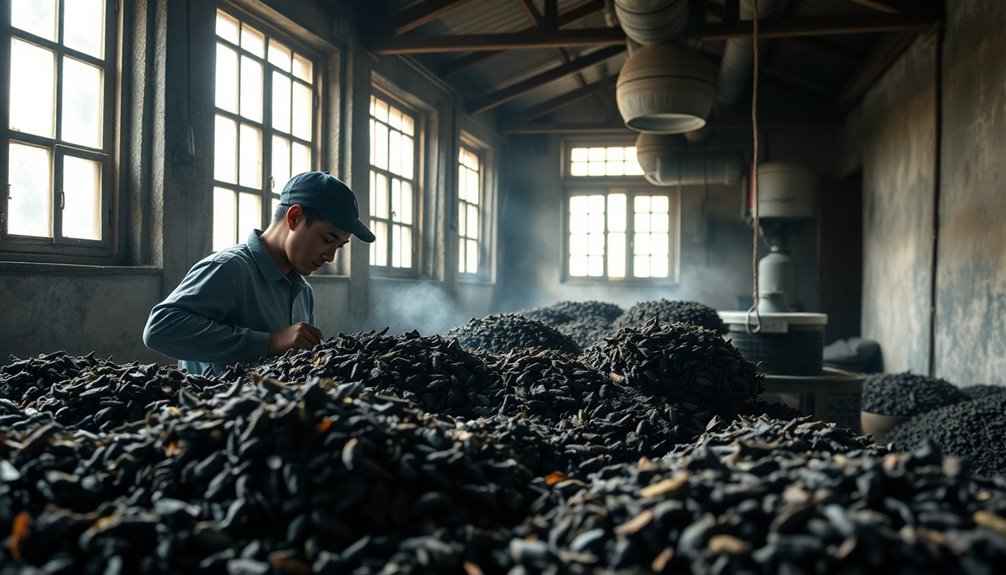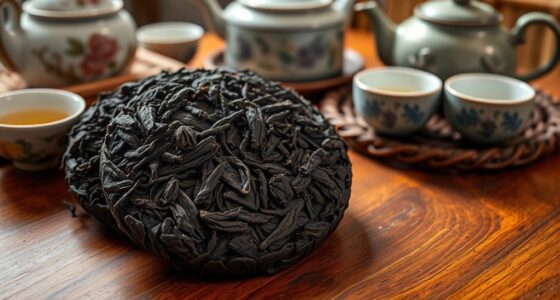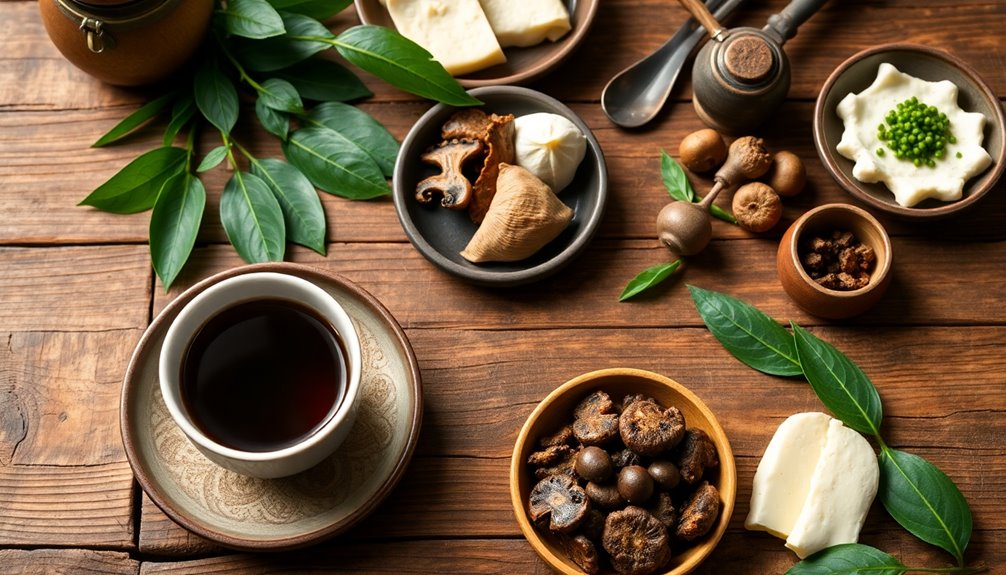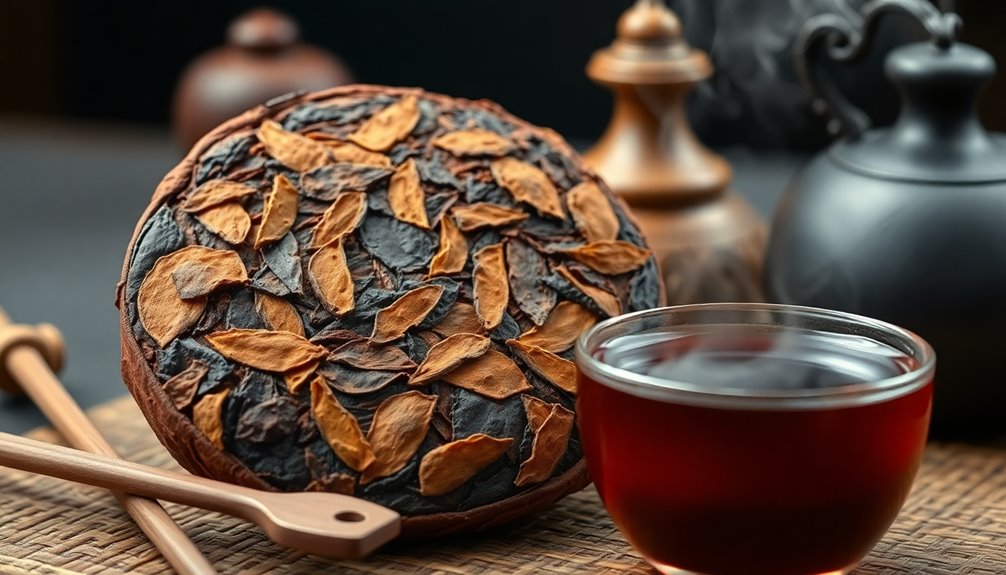Pu-erh tea originated in Yunnan Province, China, around 225 BC. It first traded during the Tang Dynasty, where merchants compressed leaves for easy transport. This tea grew popular in the Qing Dynasty for its rich, earthy flavor. It played a vital role in Yunnan's culture, often served at social gatherings and festivals, symbolizing hospitality. Known for its health benefits, Pu-erh aids digestion and promotes good skin. However, it's important to buy from trusted sources, as quality can vary. As you explore its rich history, you'll uncover even more exciting facts and stories surrounding this unique tea.
Key Takeaways
- Pu-erh tea originated in Yunnan Province, China, around 225 BC and was first traded during the Tang Dynasty for easier transport.
- The tea gained popularity in the Qing Dynasty after a decline during the Ming Dynasty, known for its rich, earthy flavor.
- The term "Pu-erh" comes from a trading post in Yunnan, with tea historically exchanged along the Tea Horse Roads.
- Pu-erh tea plays a vital cultural role in Yunnan, symbolizing hospitality and featuring in social gatherings and local festivals.
- It is renowned for its medicinal properties, aiding digestion, detoxification, and promoting overall wellness due to high antioxidant levels.
Introduction

Originating in Yunnan Province, China, around 225 BC, Pu-erh tea is one of the oldest teas known to humanity. This unique tea stands out due to its special fermentation process, which helps preserve and enhance its flavor.
You might be surprised to learn that Pu-erh tea was first traded during the Tang Dynasty, around 618-907 AD. Merchants compressed the leaves, making it easier to transport.
Although Pu-erh lost some popularity during the Ming Dynasty, it bounced back in the Qing Dynasty and became a staple in many households. Today, you'll find Pu-erh tea in various forms, each offering its own distinct taste and aroma. It's often compared to black tea but has a richer, earthier flavor profile.
As more people discover its health benefits, such as aiding digestion and providing antioxidants, Pu-erh tea is gaining traction in Western markets.
Whether you enjoy a warm cup in the morning or a refreshing iced version in the afternoon, Pu-erh tea connects you to a rich history that spans centuries. So, why not explore this ancient beverage and savor its unique qualities?
Yunnan's Ancient Tea Trade

Yunnan's tea trade has roots that stretch back to the Eastern Han Dynasty, around 25-220 CE, making it a vital part of the region's history.
Initially, tea was transported along the Silk Road, connecting different regions and cultures. As time went on, during the Tang Dynasty (AD 618-907), merchants started compressing tea leaves into bricks. This change made transport easier and helped Yunnan become a key player in the tea trade.
The term "Pu-erh" comes from a trading post in central Yunnan, known for its high-quality teas sourced from nearby mountains.
Pu-erh teas gained popularity for their unique flavors and health benefits. They were traditionally transported along the Tea Horse Roads, where they were exchanged for horses and other goods. This practice boosted their value in trade networks.
Cultural Significance in Yunnan

Although many may think of tea simply as a beverage, in Yunnan, Pu-erh tea embodies a rich cultural heritage that goes beyond taste. This tea has been part of local life for centuries, cherished for its unique flavor and health benefits.
When you visit Yunnan, you'll notice how Pu-erh tea plays a vital role in social gatherings. It's often served to guests, symbolizing hospitality and respect, making every sip a part of shared experiences.
The production of Pu-erh tea showcases traditional processing methods passed down through generations. These methods reflect the local terroir, where the region's climate and soil greatly influence the tea's distinct flavors.
Throughout the year, Yunnan hosts festivals celebrating this beloved beverage, honoring the craftsmanship behind tea production.
As you explore Yunnan, take the time to appreciate the cultural significance of Pu-erh tea. It's not just about enjoying a cup; it's about connecting with the history and community that have thrived around it.
Tea as a Medicinal Remedy

Pu-erh tea's medicinal properties have captivated health enthusiasts for centuries, offering a natural remedy for various ailments. This unique tea is renowned for its high antioxidant levels, which are boosted by its special fermentation process. This process not only helps preserve its rich flavor but also enhances its health benefits, making aged Pu-erh especially popular among wellness lovers.
In traditional Chinese medicine, you'll find that Pu-erh tea is often recommended to aid digestion and detoxify the body. People believe drinking this tea can also promote healthy skin due to its beneficial compounds. Historical records show that it has been consumed for centuries, proving its effectiveness as a staple remedy in various herbal practices.
Research suggests that drinking Pu-erh tea may improve blood circulation, lower blood pressure, and even enhance insulin sensitivity. These qualities add to its appeal for those looking to maintain a healthy lifestyle.
Quality Control Issues

Ensuring quality control in Pu-erh tea production is crucial for maintaining its flavor and safety. You mightn't realize it, but the fermentation process can greatly influence the tea's taste. If it's done improperly, it can lead to contamination, ruining your tea experience.
With the rising popularity of Pu-erh, counterfeit products are popping up everywhere. That's why it's essential to buy from trusted sources to guarantee authenticity and quality.
Another important aspect is organic certification. Non-organic teas can contain harmful substances, so quality control measures help verify that organic practices are followed.
Also, the aging conditions of Pu-erh teas significantly affect the final product. Improper storage or exposure to air can create undesirable flavors, which is why rigorous quality control during both production and storage is necessary.
Lastly, the high value of rare aged Pu-erh teas has led to increased scrutiny. Consumers like you're demanding transparency in sourcing and production methods.
This ensures that you get the quality you expect while protecting your interests as a tea lover. So, always be mindful of these quality control issues when selecting your Pu-erh tea!
Practical Applications

When it comes to enjoying Pu-erh tea, its practical applications extend far beyond mere consumption. You can explore the health benefits of this unique tea, which comes from the Camellia sinensis plant. Its aging and fermentation process allows Pu-erh tea to develop rich flavors while potentially improving digestion and metabolism.
One exciting aspect is that high-quality Pu-erh can be steeped multiple times, often yielding 10-12 infusions before the flavor starts to fade. This makes it an economical choice for tea lovers.
To brew it traditionally, try using a Yixing teapot or a gaiwan. These methods let you control steeping time and temperature, helping to maximize the unique flavor of each cup.
Modern twists on Pu-erh are also gaining popularity. You might find blends like Coconut Cacao or Dark Chocolate Peppermint, which cater to both seasoned drinkers and newcomers seeking new experiences.
Frequently Asked Questions
What Is the History of Pu-Erh Tea?
Pu-erh tea's history starts in ancient Yunnan, where you'll find its unique flavor and preservation qualities. Over centuries, it evolved from local favorite to global sensation, prized for its health benefits and distinct aging process.
What Is the History of Tea in Ancient China?
Tea in ancient China began as a medicinal drink during the Shang Dynasty. It evolved into a popular beverage by the Eastern Han, blossomed in social rituals during the Tang, and became a staple by the Ming Dynasty.
What Is Special About Puer Tea?
Pu-erh tea's aging process makes it unique; it improves in flavor complexity and mellowness over time. You'll appreciate its rich profiles, especially the difference between Sheng and Shou, enhancing your tea experience significantly.
What Does Pu-Erh Mean in English?
In English, "Pu-erh" translates to "dark tea." This reflects its unique classification as a fermented tea, distinguishing it from other varieties and highlighting its rich, complex flavors and aging potential that you'll surely appreciate.
Conclusion
In conclusion, pu-erh tea has a rich history that connects ancient China to today. You've learned about its roots in Yunnan, its cultural importance, and even its use as a medicine. While quality can vary, enjoying pu-erh tea can be a delightful experience. So next time you sip this unique tea, remember its fascinating journey. Explore different types, share with friends, and appreciate the flavors that have been cherished for centuries!










